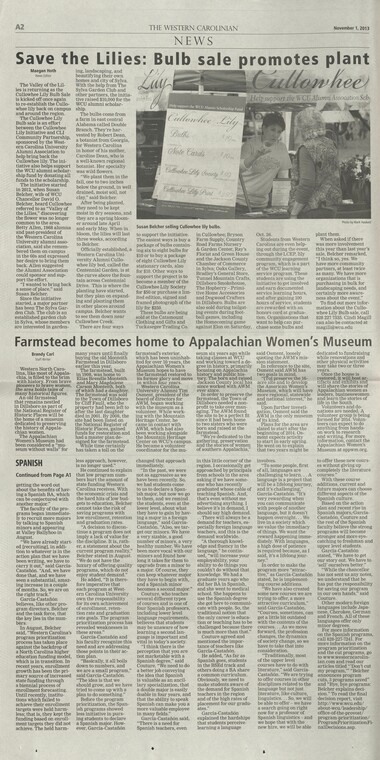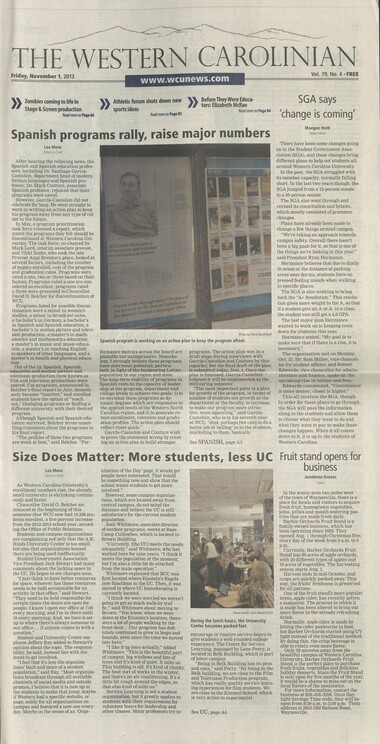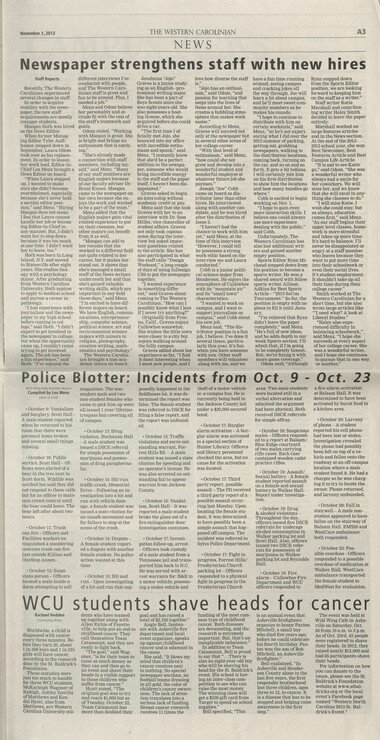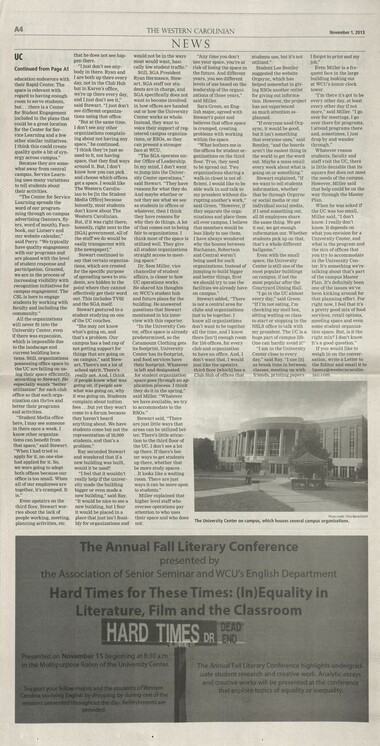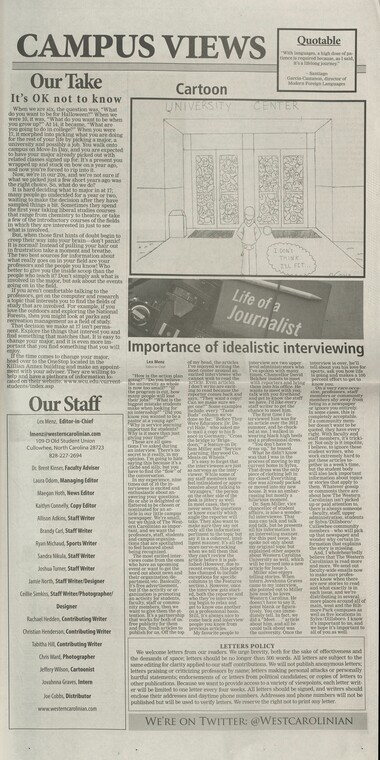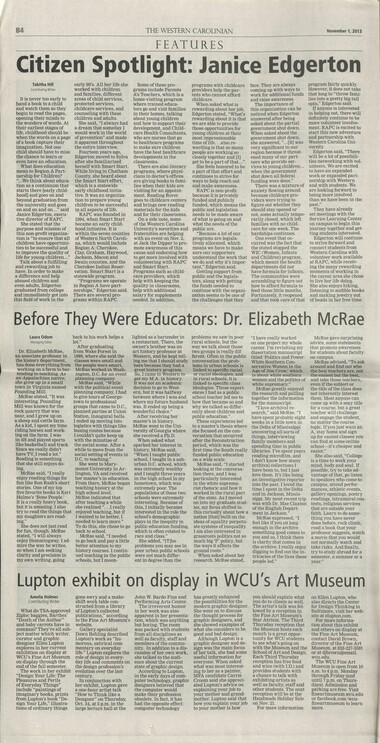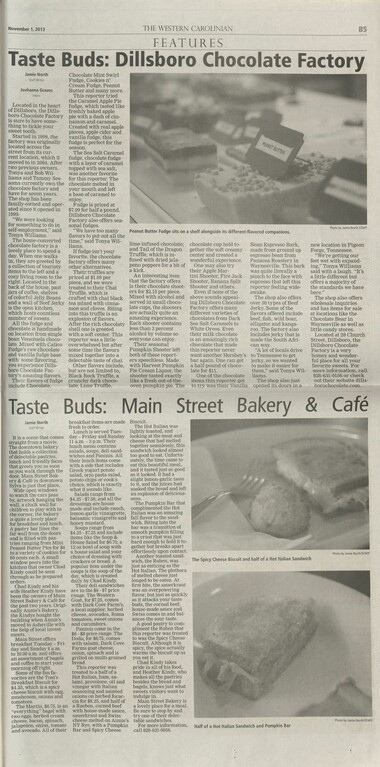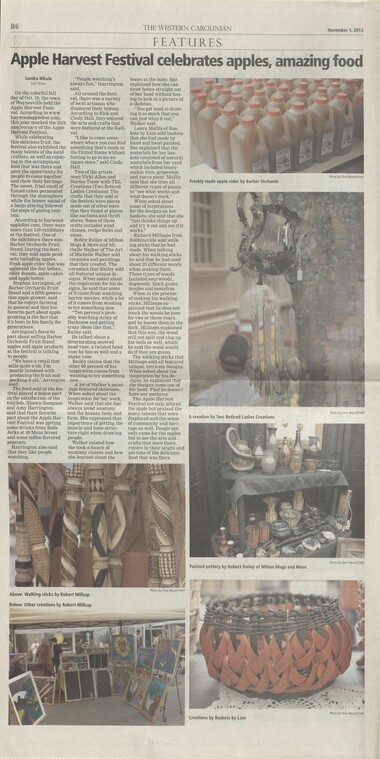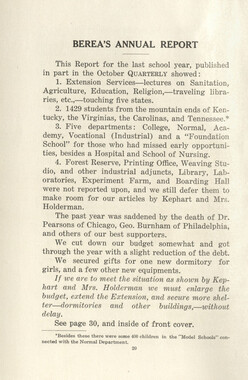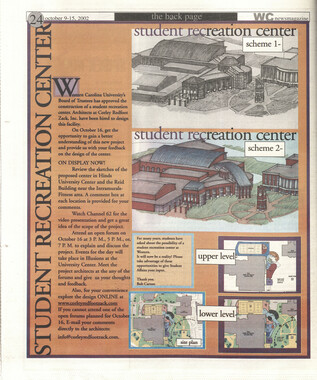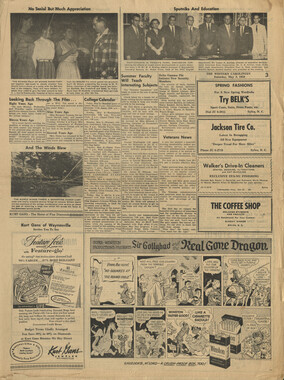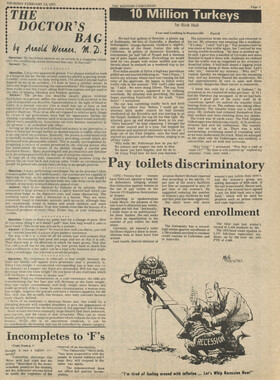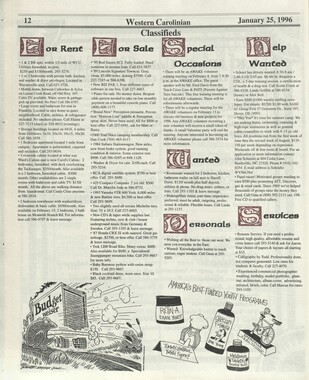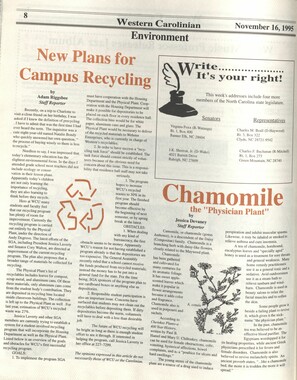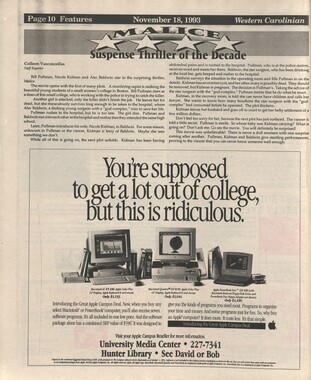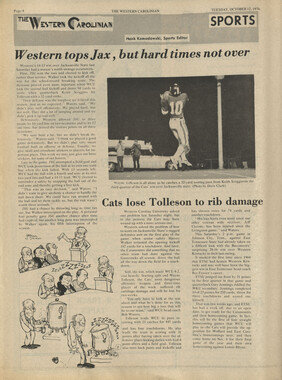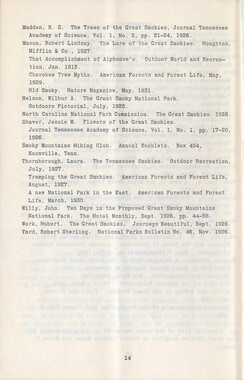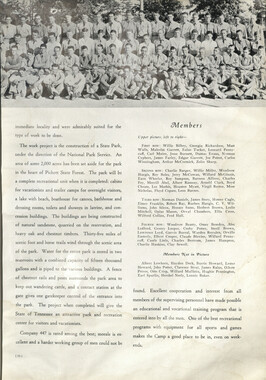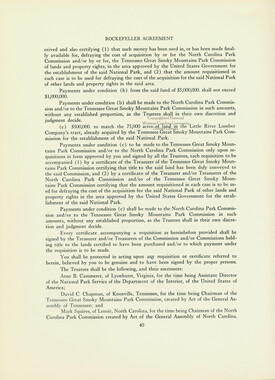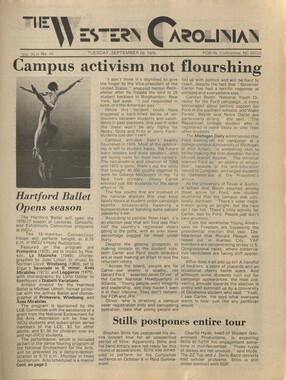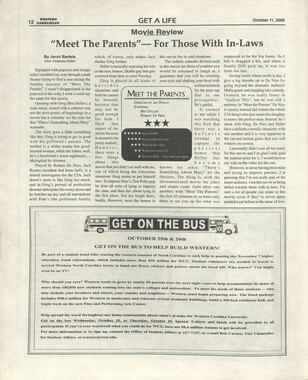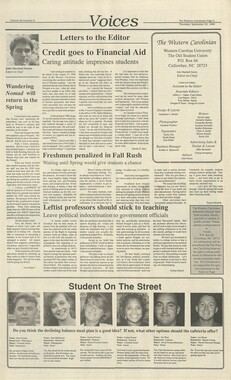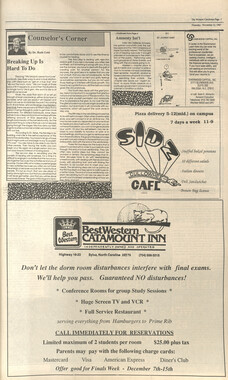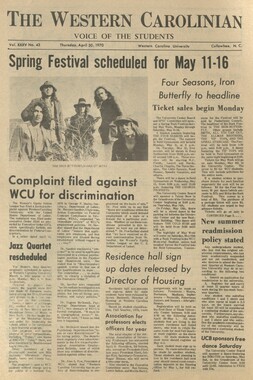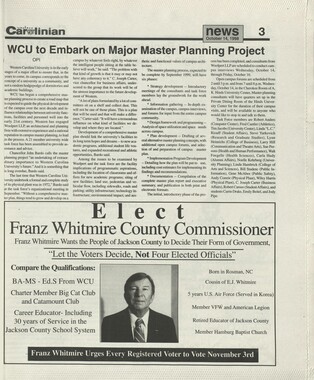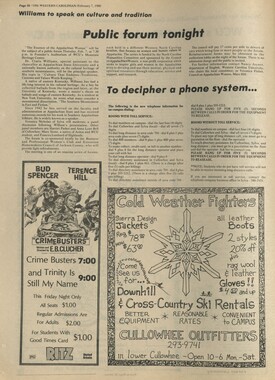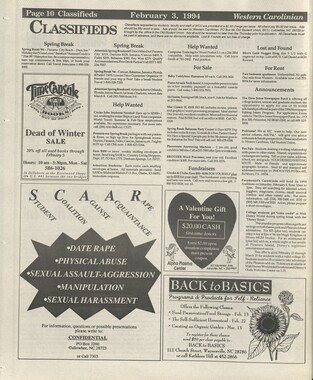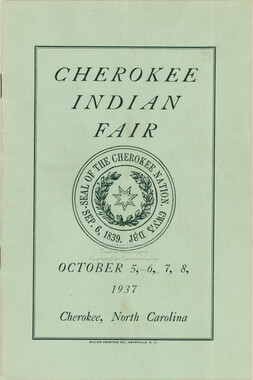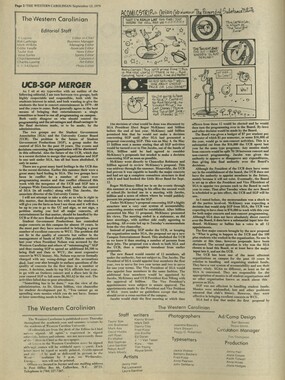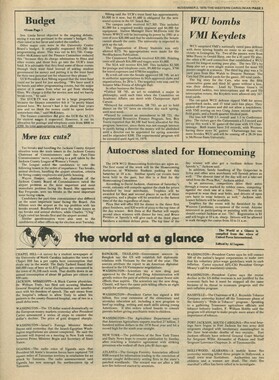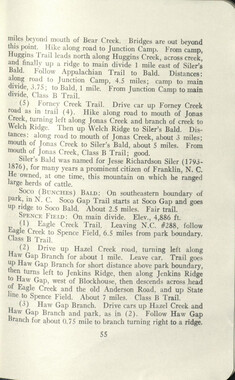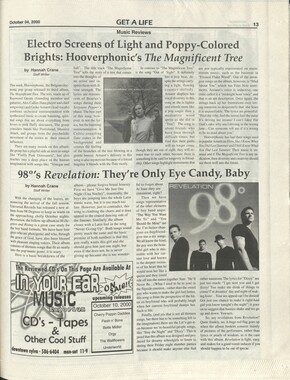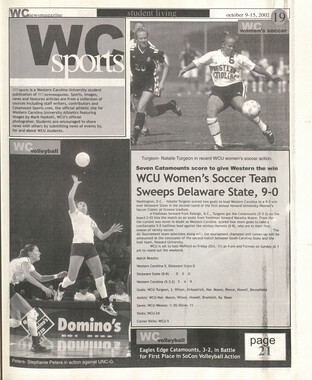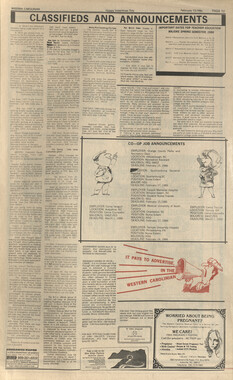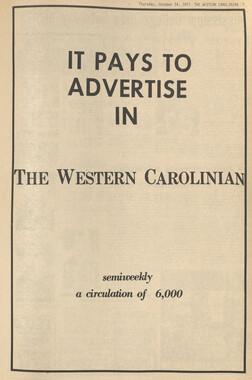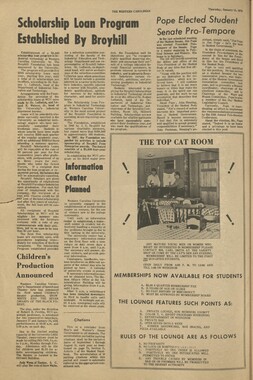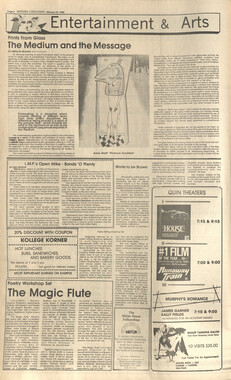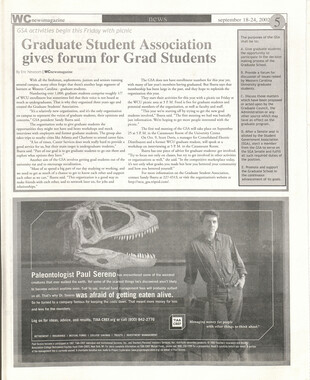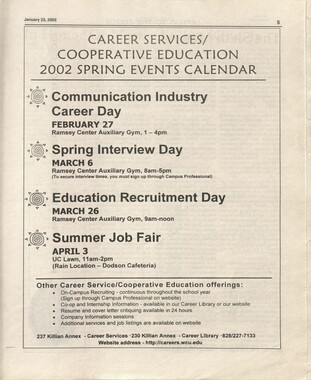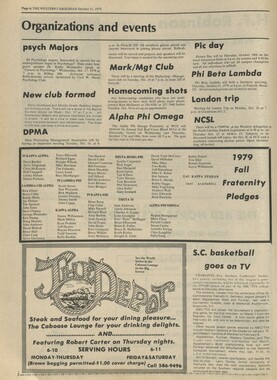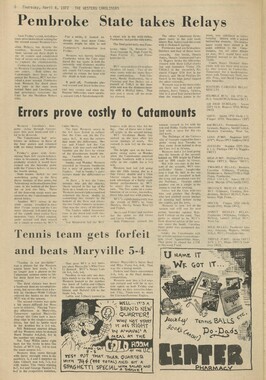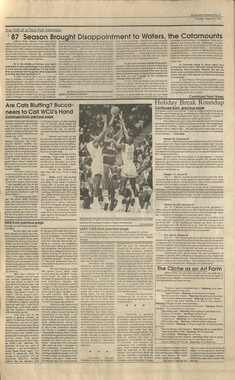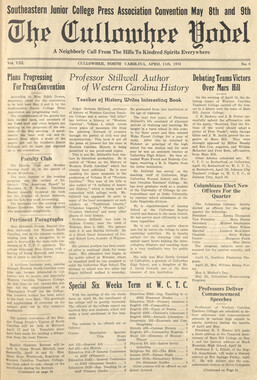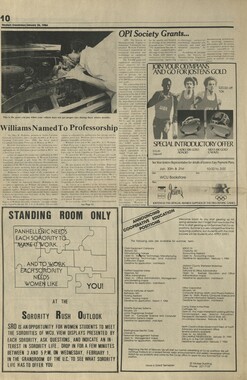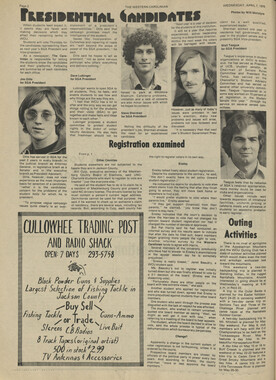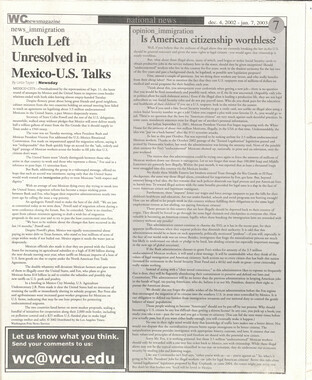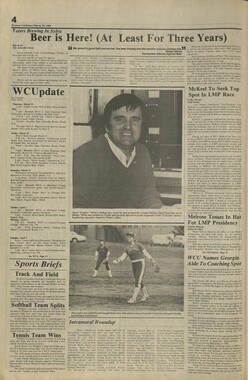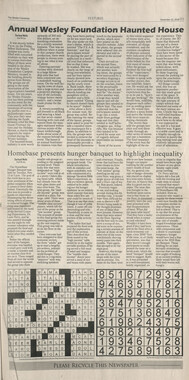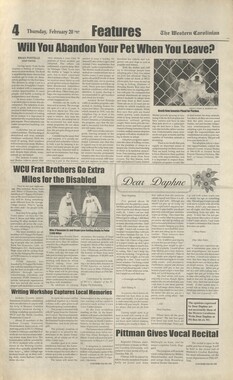Western Carolina University (21)
View all
- Canton Champion Fibre Company (2308)
- Cherokee Traditions (291)
- Civil War in Southern Appalachia (165)
- Craft Revival (1942)
- George Masa Collection (137)
- Great Smoky Mountains - A Park for America (2900)
- Highlights from Western Carolina University (422)
- Horace Kephart (941)
- Journeys Through Jackson (159)
- LGBTQIA+ Archive of Jackson County (85)
- Oral Histories of Western North Carolina (314)
- Picturing Appalachia (6797)
- Stories of Mountain Folk (413)
- Travel Western North Carolina (153)
- Western Carolina University Fine Art Museum Vitreograph Collection (129)
- Western Carolina University Herbarium (92)
- Western Carolina University: Making Memories (738)
- Western Carolina University Publications (2491)
- Western Carolina University Restricted Electronic Theses and Dissertations (146)
- Western North Carolina Regional Maps (71)
- World War II in Southern Appalachia (131)
University of North Carolina Asheville (6)
View all
- Allanstand Cottage Industries (62)
- Appalachian National Park Association (53)
- Bennett, Kelly, 1890-1974 (1463)
- Berry, Walter (76)
- Brasstown Carvers (40)
- Carver, George Washington, 1864?-1943 (26)
- Cathey, Joseph, 1803-1874 (1)
- Champion Fibre Company (233)
- Champion Paper and Fibre Company (297)
- Cherokee Indian Fair Association (16)
- Cherokee Language Program (22)
- Crowe, Amanda (40)
- Edmonston, Thomas Benton, 1842-1907 (7)
- Ensley, A. L. (Abraham Lincoln), 1865-1948 (275)
- Fromer, Irving Rhodes, 1913-1994 (70)
- George Butz (BFS 1907) (46)
- Goodrich, Frances Louisa (120)
- Grant, George Alexander, 1891-1964 (96)
- Heard, Marian Gladys (60)
- Kephart, Calvin, 1883-1969 (15)
- Kephart, Horace, 1862-1931 (313)
- Kephart, Laura, 1862-1954 (39)
- Laney, Gideon Thomas, 1889-1976 (439)
- Masa, George, 1881-1933 (61)
- McElhinney, William Julian, 1896-1953 (44)
- Niggli, Josephina, 1910-1983 (10)
- North Carolina Park Commission (105)
- Osborne, Kezia Stradley (9)
- Owens, Samuel Robert, 1918-1995 (11)
- Penland Weavers and Potters (36)
- Roberts, Vivienne (15)
- Roth, Albert, 1890-1974 (142)
- Schenck, Carl Alwin, 1868-1955 (1)
- Sherrill's Photography Studio (2565)
- Southern Highland Handicraft Guild (127)
- Southern Highlanders, Inc. (71)
- Stalcup, Jesse Bryson (46)
- Stearns, I. K. (213)
- Thompson, James Edward, 1880-1976 (226)
- United States. Indian Arts and Crafts Board (130)
- USFS (683)
- Vance, Zebulon Baird, 1830-1894 (1)
- Weaver, Zebulon, 1872-1948 (58)
- Western Carolina College (230)
- Western Carolina Teachers College (282)
- Western Carolina University (2008)
- Western Carolina University. Mountain Heritage Center (18)
- Whitman, Walt, 1819-1892 (10)
- Wilburn, Hiram Coleman, 1880-1967 (73)
- Williams, Isadora (3)
- Cain, Doreyl Ammons (0)
- Crittenden, Lorraine (0)
- Rhodes, Judy (0)
- Smith, Edward Clark (0)
- Appalachian Region, Southern (2929)
- Asheville (N.C.) (1944)
- Avery County (N.C.) (26)
- Blount County (Tenn.) (195)
- Buncombe County (N.C.) (1680)
- Cherokee County (N.C.) (283)
- Clay County (N.C.) (556)
- Graham County (N.C.) (238)
- Great Smoky Mountains National Park (N.C. and Tenn.) (525)
- Haywood County (N.C.) (3571)
- Henderson County (N.C.) (70)
- Jackson County (N.C.) (4917)
- Knox County (Tenn.) (35)
- Knoxville (Tenn.) (13)
- Lake Santeetlah (N.C.) (10)
- Macon County (N.C.) (420)
- Madison County (N.C.) (216)
- McDowell County (N.C.) (39)
- Mitchell County (N.C.) (135)
- Polk County (N.C.) (35)
- Qualla Boundary (982)
- Rutherford County (N.C.) (78)
- Swain County (N.C.) (2185)
- Transylvania County (N.C.) (270)
- Watauga County (N.C.) (12)
- Waynesville (N.C.) (86)
- Yancey County (N.C.) (72)
- Aerial Photographs (3)
- Aerial Views (60)
- Albums (books) (4)
- Articles (1)
- Artifacts (object Genre) (228)
- Bibliographies (1)
- Biography (general Genre) (2)
- Cards (information Artifacts) (38)
- Clippings (information Artifacts) (191)
- Copybooks (instructional Materials) (3)
- Crafts (art Genres) (622)
- Depictions (visual Works) (21)
- Design Drawings (1)
- Drawings (visual Works) (185)
- Envelopes (73)
- Exhibitions (events) (1)
- Facsimiles (reproductions) (1)
- Fiction (general Genre) (4)
- Financial Records (12)
- Fliers (printed Matter) (67)
- Glass Plate Negatives (381)
- Guidebooks (2)
- Internegatives (10)
- Interviews (815)
- Land Surveys (102)
- Letters (correspondence) (1013)
- Manuscripts (documents) (618)
- Maps (documents) (177)
- Memorandums (25)
- Minutes (administrative Records) (59)
- Negatives (photographs) (6090)
- Newsletters (1290)
- Newspapers (2)
- Notebooks (8)
- Occupation Currency (1)
- Paintings (visual Works) (1)
- Pen And Ink Drawings (1)
- Periodicals (193)
- Personal Narratives (10)
- Photographs (12976)
- Plans (maps) (1)
- Poetry (5)
- Portraits (4568)
- Postcards (329)
- Programs (documents) (181)
- Publications (documents) (2443)
- Questionnaires (65)
- Relief Prints (26)
- Sayings (literary Genre) (1)
- Scrapbooks (282)
- Sheet Music (2)
- Slides (photographs) (402)
- Songs (musical Compositions) (2)
- Sound Recordings (796)
- Specimens (92)
- Speeches (documents) (18)
- Tintypes (photographs) (8)
- Transcripts (322)
- Video Recordings (physical Artifacts) (23)
- Text Messages (0)
- A.L. Ensley Collection (275)
- Appalachian Industrial School Records (7)
- Appalachian National Park Association Records (336)
- Axley-Meroney Collection (2)
- Bayard Wootten Photograph Collection (20)
- Bethel Rural Community Organization Collection (7)
- Blumer Collection (5)
- C.W. Slagle Collection (20)
- Canton Area Historical Museum (2110)
- Carlos C. Campbell Collection (462)
- Cataloochee History Project (64)
- Cherokee Studies Collection (4)
- Daisy Dame Photograph Album (5)
- Daniel Boone VI Collection (1)
- Doris Ulmann Photograph Collection (112)
- Elizabeth H. Lasley Collection (1)
- Elizabeth Woolworth Szold Fleharty Collection (4)
- Frank Fry Collection (95)
- George Masa Collection (173)
- Gideon Laney Collection (452)
- Hazel Scarborough Collection (2)
- Hiram C. Wilburn Papers (28)
- Historic Photographs Collection (236)
- Horace Kephart Collection (861)
- Humbard Collection (33)
- Hunter and Weaver Families Collection (1)
- I. D. Blumenthal Collection (4)
- Isadora Williams Collection (4)
- Jesse Bryson Stalcup Collection (47)
- Jim Thompson Collection (224)
- John B. Battle Collection (7)
- John C. Campbell Folk School Records (80)
- John Parris Collection (6)
- Judaculla Rock project (2)
- Kelly Bennett Collection (1482)
- Love Family Papers (11)
- Major Wiley Parris Civil War Letters (3)
- Map Collection (12)
- McFee-Misemer Civil War Letters (34)
- Mountain Heritage Center Collection (4)
- Norburn - Robertson - Thomson Families Collection (44)
- Pauline Hood Collection (7)
- Pre-Guild Collection (2)
- Qualla Arts and Crafts Mutual Collection (12)
- R.A. Romanes Collection (681)
- Rosser H. Taylor Collection (1)
- Samuel Robert Owens Collection (94)
- Sara Madison Collection (144)
- Sherrill Studio Photo Collection (2558)
- Smoky Mountains Hiking Club Collection (616)
- Stories of Mountain Folk - Radio Programs (374)
- The Reporter, Western Carolina University (510)
- Venoy and Elizabeth Reed Collection (16)
- WCU Gender and Sexuality Oral History Project (32)
- WCU Mountain Heritage Center Oral Histories (25)
- WCU Oral History Collection - Mountain People, Mountain Lives (71)
- WCU Students Newspapers Collection (1923)
- Western North Carolina Tomorrow Black Oral History Project (69)
- William Williams Stringfield Collection (2)
- Zebulon Weaver Collection (109)
- African Americans (390)
- Appalachian Trail (35)
- Artisans (521)
- Cherokee art (84)
- Cherokee artists -- North Carolina (10)
- Cherokee language (21)
- Cherokee pottery (101)
- Cherokee women (208)
- Church buildings (190)
- Civilian Conservation Corps (U.S.) (111)
- College student newspapers and periodicals (2012)
- Dams (108)
- Dance (1023)
- Education (222)
- Floods (61)
- Folk music (1015)
- Forced removal, 1813-1903 (2)
- Forest conservation (220)
- Forests and forestry (1196)
- Gender nonconformity (4)
- Great Smoky Mountains National Park (N.C. and Tenn.) (181)
- Hunting (46)
- Landscape photography (25)
- Logging (119)
- Maps (83)
- Mines and mineral resources (9)
- North Carolina -- Maps (18)
- Paper industry (38)
- Postcards (255)
- Pottery (135)
- Railroad trains (72)
- Rural electrification -- North Carolina, Western (3)
- School integration -- Southern States (2)
- Segregation -- North Carolina, Western (5)
- Slavery (5)
- Sports (452)
- Storytelling (243)
- Waterfalls -- Great Smoky Mountains (N.C. and Tenn.) (66)
- Weaving -- Appalachian Region, Southern (280)
- Wood-carving -- Appalachian Region, Southern (328)
- World War, 1939-1945 (173)
Western Carolinian Volume 79 Number 04
Item
Item’s are ‘child’ level descriptions to ‘parent’ objects, (e.g. one page of a whole book).
-
-
A2 THE WESTERN CAROLINIAN Save the Lilies: Maegan Hoth News Editor The Valley of the Lil- ies is returning as the Cullowhee Lily Bulb Sale is kicked off once again to. re-establish the Cullo- whee lily back on campus and around the region. The Cullowhee Lily Bulb sale is an effort between the Cullowhee Lily Initiative and CLI Community Partnership, sponsored by the West- ern Carolina University Alumni Association to help bring back the Cullowhee lily. The ini- tiative also helps support the WCU alumni scholar- ship fund by donating all funds to the scholarship. The initiative started in 2012, when Susan Belcher, wife of WCU Chancellor David O. Belcher, heard Cullowhee referred to as Valley of the Lilies, discovering the flower was no longer common to the area. Betty Allen, 1968 alumna and past-president of the Western Carolina University alumni asso- ciation, said she remem- bered them on campus in the 60s and expressed her desire to bring them back. Allen suggested the Alumni Association could sponsor and sup- port the effort. T wanted to bring back a sense of place, said Susan Belcher. Since the initiative started, a major partner has been The Sylva Gar- den Club. The club is an established garden club in Sylva, whose members are interested in garden- NEWS ing, landscaping, and beautifying their own homes and city of Sylva. With the help from The Sylva Garden Club and other partners, the initia- tive raised $10,000 for the WCU alumni scholar- ship. The bulbs come from a farm in east central Alabama called Double Branch. Theyre har- vested by Robert Dean, a botanist from Georgia, for Western Carolina in honor of his mother, Caroline Dean, whois a well-known regional botanist. Her specialty was wild flowers. We plant them in the fall, one to two inches below the ground, in well drained, moist soil, not clay, said Belcher. After being planted, they need to be kept moist in dry seasons, and they are a spring bloom- er around late April and early May. When in bloom, the lilies will last three weeks, according to Belcher. Officially established, a Western Carolina Uni- versity Alumni Cullo- whee lily bed, called the Centennial Garden, is at the curve above the foun- tain across Centennial Drive. This is where the planting have started, but they plan on expand- ing and planting them in other places around campus. Belcher wants - to see them down near Cullowhee Creek. There are four ways Susan Belcher selling Cullowhee lily bulbs. to support the initiative. The easiest ways is buy a package of bulbs contain- ing six to eight bulbs for $10 or to buy a package of eight Cullowhee Lily stationary cards, also for $10. Other ways to support the project is to become a member of the Cullowhee Lily Society for $50 or purchase a lim- ited edition, signed and framed photograph of the lily for $250. These bulbs are being _ sold at the Catamount Clothing and Gifts and Tuckasegee Trading Co, in Cullowhee; Bryson Farm Supply, Country Road Farms Nursery & Garden Center, Rays Florist and Green House and the Jackson County Chamber of Commerce in Sylva; Oaks Gallery, Bradleys General Store, Tunnel Mountain Crafts, Dillsboro Smokehouse, The Hopberry Primi- tive Home Accessories and Dogwood Crafters in Dillsboro. Bulbs are also sold during tailgat- ing events during foot- ball games, including the Homecoming game against Elon on Saturday, November 1, 2013 Bulb sale promotes plant Oct. 26. Students from Western Carolina are even help- ing out during the event, through the LCEP, lily community engagement program, which is a part of the WCU learning service program. These students are using the initiative to get involved and earn documented service learning hours, and after gaining 100 hours of service, students are rewarded with an honors cord at gradua- tion. Organizations that want to help can pur- chase some bulbs and Photo by Mark Haskett plant them. When asked if there - was more involvement this year than last years sale, Belcher remarked, T think so, yes. We have more community partners, at least twice as many. We have more organizations that is purchasing in bulk for landscaping needs, and certainly more aware- ness about the event. To find out more infor- mation about the Cullo- whee Lily Bulb sale, call 828 227 7335. Cindi Magill can also be contacted at magill@wcu.edu Farmstead becomes Brandy Carl Staff Writer Western North Caro- lina, like most of Appala- chia, is filled to the brim with history. From brave pioneers to brave women, the area holds tales of many historical figures. An old farmstead that remains nestled in Dillsboro as part of the National Register of Historic Places will be the home of a museum dedicated to preserving the history of Appala- chian women. The Appalachian Womens Museum had been considered a mu- seum without walls for SPANISH Continued from Page A1 getting the word out about the benefits of hav- ing a Spanish BA, which can be conjectured with another major. The faculty of the pro- grams began immediate- ly to recruit more majors by talking to Spanish minors and appearing at Valley Ballyhoo in August. We have already start- ed [recruiting], in addi- tion to whatever is in the action plan that we have been writing, we have to carry it out, said Garcia- Castanon. And, we have done that, and we have seen a substantial, amaz- ing increase in a couple of months. So, we are on the right track. Garcia-Castanon believes, like other pro- gram directors, Belcher and the task force, that the key lies in the num- bers. In August, Belcher said, Western Carolinas program prioritization process has taken place against the backdrop of a North Carolina higher education funding model, which is in transition. In recent years, enrollment growth has been the pri- mary source of increased state funding through a biennial process of enrollment forecasting. Until recently, institu- tions which failed to achieve their enrollment targets were held harm- less; that is, they kept the funding based on enroll- ment targets they did not achieve. The held harm- many years until finally buying the old Monteith Farmstead in Dillsboro earlier this year. The farmstead, built in 1908, was home to Elias Brendle Monteith and Mary Magdalene Carson Monteith, both of which had a daughter. - The farmstead was sold to the Town of Dillsboro by Cliff Faull, who the property had been left to after the last daughter died in 2001. By 2008, the site had been listed on the National Register of Historic Places, gained funds for restoration and had a master plan de- signed for the farmstead. While time certainly has taken a toll on the less approach, however, is no longer used. He continued to explain that low program num- bers hurt the amount of state funding Western Carolina receives. With the economic crisis and the hard hits of low bud- gets to education, Belcher cannot take the risk of saving programs with low enrollment, retention and graduation rates. A decision to discon- tinue a program does not imply a lack of value for the discipline. It is, rath- _ er, a statement about the current program reality, Belcher stated in August. We do not have the luxury of offering quality programs, which do not enjoy student demand. He added, It is there- fore imperative that each program at West- ern Carolina University own the responsibility for its own achievement of enrollment, reten- tion rate and graduation rate goals. The program prioritization process has revealed weaknesses in these areas. Garcia-Castanon and his faculty recognize this need and are addressing those points in their ac- tion plan. Basically, it all boils down to numbers, and we area small program, said Garcia-Castanon. The idea is that we should grow, and we have tried to come up witha plan to do something. Before the program prioritization, the Span- ish programs showed less initiative in purs- ing students to declare a Spanish major. How- ever, Garcia-Castanon home to Appalachian Womens Museum farmsteads exterior, which has been uninhab- ited for over 10 years, the Appalachian Womens Museum hopes to have the farmstead restored to its former glory and move in within four years. Western Carolina University Alumni Tim Osment, president of the board of directors for AWM, began working with the museum as a volunteer. While work- ing with the Mountain Heritage Center, he came in contact with AWM, which had also been working alongside the Mountain Heritage Center on WCUs campus. He became a volunteer coordinator for the mu- changed that approach immediately. Tn the past, we were not as aggressive as we have been recently. So, we had students come to us to declare a Span- ish major, but now we go to them, and we remind the students, even at the lower level, about what they have to gain by hav- ing a major in a foreign language, said Garcia- Castanon. Also, we tar- get our minors. We have avery sizable, a good number of minors, a very healthy number. We have been more vocal with our minors and found how long it takes for them to upgrade from a minor to a major. Of course, they can keep whatever major they have to begin with, andaSpanishminor _ becomes a second major. Couture, who teaches several different types of courses and is one of four Spanish professors, including lower level language requirements, believes that students may be unaware of how learning a second lan- guage is important and vital in todays society. T think there is the perception that you are not marketable with a Spanish degree, said Couture. We need to do a better job conveying the idea that Spanish is valuable as an ancil- lary specialization, that a double major is easily doable in four years, and that the ability to speak Spanish can make youa more valuable employee in many fields. Garcia-Castanon said, There is a need for Spanish teachers, even seum six years ago while taking classes at WCU and working toward a de- gree in history, primarily ocusing on Appalachia history and public his- tory. The born and raised Jackson County local has since worked with AWM ~ ever since. In order to preserve the farmstead, the Town of Dillsboro needed a non- profit to take over man- aging. The AWM found the site to be a perfect fit since it had been home to two sisters who were born and raised at the farmstead. We're dedicated to the gathering, preservation and the stories of women of southern Appalachia, in this little corner of the region. I occasionally get approached by principals from schools in the area asking if we have some- one who has recently graduated whose cable of teaching Spanish. And, thats even without me advertising anything. I believe its in demand, I should say high demand. .. There will always bea demand for teachers, es- pecially foreign language teachers, and this is the demand worldwide. A thorough knowl- edge and fluency in the language, he contin- ued, will increase your employability, your ability to do things you couldnt do without that knowledge. We hada graduate years ago who did her BA in Spanish, and she went to medical school. She happens to use the Spanish degree she got here to communi- cate with people. So, the traditional notion that the only career is educa- tion or teaching has to be challenged because there is much more than that. Couture agreed and mentioned the impor- tance of teachers like Garcia-Castanon. He added, As far as Spanish goes, students in the BSEd track and others doing a BA share a common curriculum, Obviously, we need to make students aware of the demand for Spanish teachers in the region and of the high rates of placement for our gradu- ates. Garcia-Castanon explained the hardships that students perceive learning a language said Osment, loosely | quoting the AWMs mis- sion statement. In reference to the site, Osment said AWM has two goals in mind. TTo] preserve the 16- acre site and to develo the American. Womens Museum, which will have more regional, statewide and national interest, he said. Upon further investi- gation, Osment said the AWM is the only museum of its kind. Plans for the area are slated to start after the beginning of 2014. Os- ment expects activity to start in early spring. He went on to explain that two years might be involves. To some people, first . of all, languages are challenging to learn...A language is a project that will be a lifelong journey, and its challenging, Garcia-Castanon. Its very rewarding when you can communicate with people of another language, but it doesnt happen overnight... We live in a society which we value the immediacy of things. We want the reward happening imme- diately. With languages, a high dose of patience is required because, as I said, its a lifelong jour- ney. In order to make the program more attrac- tive, as Garcia-Castanon stated, he is implement- ing course additions. We have also created some new courses we are trying to offer, a more attractive curriculum, said Garcia-Castanon. Courses, sometimes, can get a little bit outdated with the contents of the courses... AS we move forward, the profession changes, the dynamics of society change, so we have to take that into consideration. Traditionally, most of the upper level courses have to do with literature, said Garcia- Castanon. We are trying to offer courses in other disciplines related to the language but not just literature, like culture, linguistics. .. So, we will be able to offer we have a search going on right now for a professor of Spanish linguistics and we hope that with the new hire, we will be able dedicated to fundraising while renovations and other physical activities may take two or three years. Once the house is restored, it will host ar- tifacts and exhibits and will share the stories of ea women as leaders, businesswomen and learn the stories of life in the South. Volunteers and do- nations are needed. A volunteer group is being formed for 2014. Volun- teers can expect to do anything from hands- on work to research and writing. For more information, contact the Appalachian Womens Museum at appwm.org. to offer these new cours- es without giving up completely the literature courses. With these course additions, current and future majors can choose different aspects of the Spanish culture. Based on the action plan and recent rise in Spanish majors,Garcia- Castanon, Couture and the rest of the Spanish faculty believe the strong programs will become stronger and more eye- catching to freshman and upper level students. Garcia-Castanon stated, We have to get our story out. We have to sell ourselves better. While the chancellor has not sent us any notes, we understand that he has put the responsibility for saving our program in our own hands, said Couture. Other modern foreign languages include Japa- nese, Cherokee, German and French. All of these languages offer only minor degrees. For more information on the Spanish programs, call 828-227-7241. For more information on the program prioritization and the cut programs, go to www.westerncarolin- ian.com and read our articles titled Dont cut my program, Belcher announces program cuts, 3 programs saved and Bye, bye programs: Belcher explains deci- sion. To read the final decision report, visit http://www.wcu.edu/ about-wcu/leadership/ office-of-the-provost/ program-prioritization/ ProgramPrioritizationFi- nalDecisions.asp.
Object
Object’s are ‘parent’ level descriptions to ‘children’ items, (e.g. a book with pages).
-
The Western Carolinian is Western Carolina University's student-run newspaper. The paper was published as the Cullowhee Yodel from 1924 to 1931 before changing its name to The Western Carolinian in 1933.
-
